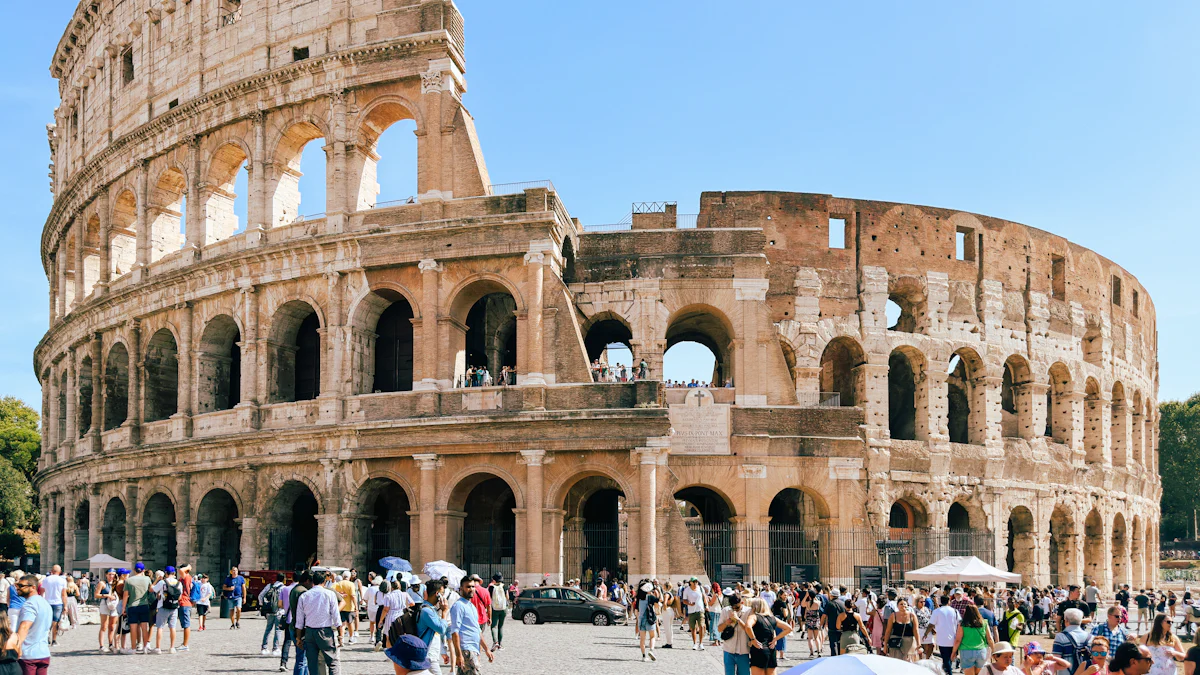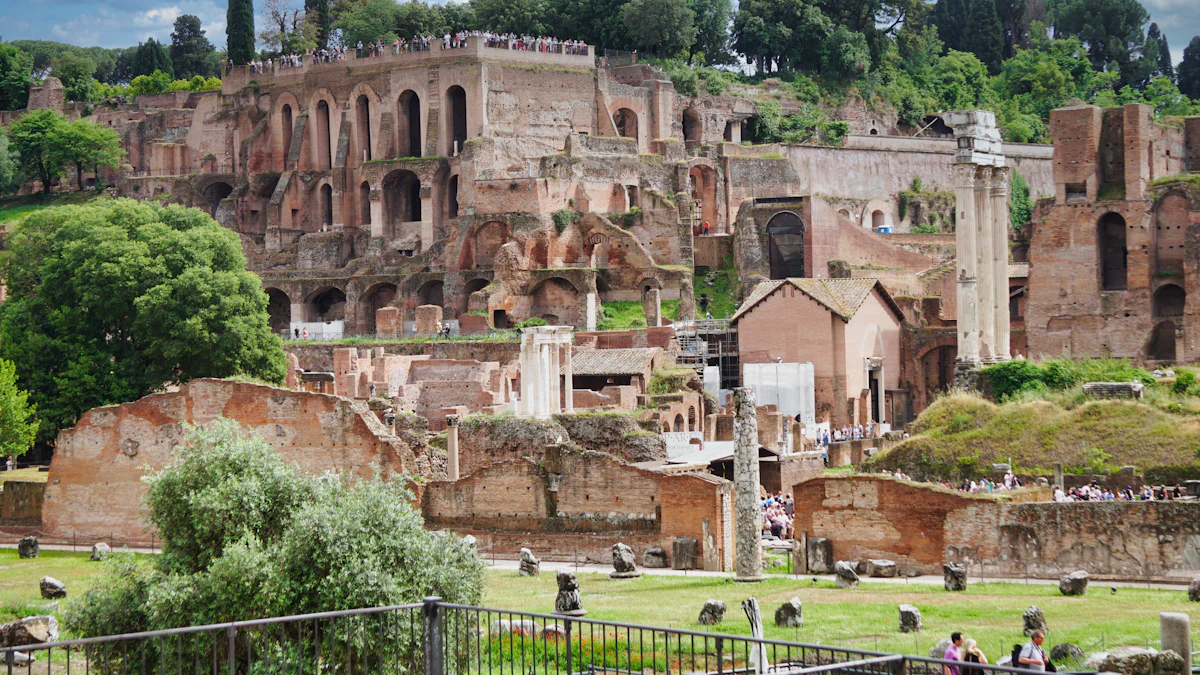Ancient Rome: An Illustrated History

Ancient Rome captivates with its grandeur and mystery. The city of Rome itself once housed over 1 million people, showcasing the empire's vast reach. Ancient letters and records reveal a society rich in culture and innovation. The Illustrated History by Hazel Dodge provides a detailed account of this era. Rome, Ancient, History, Roman civilizations shaped modern governance, architecture, and law. The book focuses on these influences, offering insights into the empire's enduring legacy. The History by Hazel Dodge captures the essence of Rome's impact on the modern world.
The Rise of Rome
Founding Myths and Early History

Romulus and Remus
The legendary tale of Romulus and Remus forms the cornerstone of Rome's origin story. According to tradition, these twin brothers were the sons of Mars, the god of war, and Rhea Silvia, a Vestal Virgin. Abandoned as infants, they faced certain death in the Tiber River. A she-wolf discovered the twins and nurtured them, an image that has become emblematic of Rome itself. In 753 BCE, Romulus established the city of Rome, marking the beginning of its illustrious history. Although historians debate the precise date, the general consensus places the founding in the 8th century BCE. This myth underscores the city's connection to divine intervention and destiny.
The Etruscan Influence
The early development of Rome was significantly shaped by the Etruscans. This neighboring civilization contributed to Roman architecture and law. Etruscan influence is evident in the construction techniques and artistic styles adopted by the Romans. The Etruscans also played a crucial role in shaping Rome's political and social structures. As Rome expanded, it absorbed elements from the cultures it encountered, creating a rich tapestry of legal and cultural principles. The integration of Etruscan and Greek customs laid the groundwork for Rome's future greatness.
The Roman Republic
Political Structure
The establishment of the Roman Republic marked a significant shift in governance. Rome transitioned from a monarchy to a republic, introducing a complex political system. The Republic featured a Senate, which held significant power, and elected officials known as consuls. This structure allowed for a balance of power and representation among the Roman citizens. The political system of the Republic served as a model for future governments, influencing modern democratic practices.
Key Conflicts and Expansion
The Roman Republic experienced numerous conflicts that fueled its expansion. The Punic Wars against Carthage stand out as pivotal events in Roman history. These wars showcased Rome's military prowess and strategic acumen. Victory in the Punic Wars allowed Rome to dominate the Mediterranean region. The Republic's expansion brought wealth and resources, but also internal challenges. The assassination of Julius Caesar highlighted the tensions within the Republic, leading to its eventual transformation into an empire.
The Roman Empire
Augustus and the Pax Romana
Establishment of the Empire
Augustus emerged as a pivotal figure in Ancient Rome's history. The Senate bestowed the title of Augustus upon Octavian, marking the beginning of the Roman Empire. This event initiated the Pax Romana, a period characterized by peace and stability across the empire. Augustus's reign brought significant advancements in engineering and the arts. The city of Nimes witnessed architectural achievements, including the construction of the Arena of Nimes, one of the largest amphitheaters in Gaul. Augustus's leadership set the foundation for a flourishing empire.
Cultural Flourishing
The Pax Romana witnessed a cultural renaissance in Rome. Literature thrived under Augustus's rule, with poets like Virgil, Horace, and Livy producing enduring works. These literary achievements reflected the values and aspirations of the empire. Monumental structures such as Hadrian's Wall, the Colosseum, and the Temple of Peace showcased Roman architectural prowess. The empire's art and architecture reached new heights during this era. The Pax Romana symbolized a golden age of cultural achievement in Ancient Rome.
Notable Emperors and Their Legacies
Nero and the Great Fire
Nero remains one of the most infamous emperors in Roman history. His reign is often associated with the Great Fire of Rome in 64 CE. Historical accounts suggest that Nero's response to the disaster was inadequate. The fire devastated much of the city, leading to widespread suffering. Nero's legacy is marred by accusations of tyranny and extravagance. The Great Fire of Rome serves as a cautionary tale about leadership and responsibility.
Constantine and Christianity
Constantine played a transformative role in the Roman Empire's religious landscape. He became the first Roman emperor to convert to Christianity. The Edict of Milan in 313 CE legalized Christianity, ending centuries of persecution. Constantine's support for Christianity reshaped the religious identity of the empire. The establishment of Constantinople as a new capital further solidified his influence. Constantine's legacy endures through his contributions to the spread of Christianity in Ancient Rome.
Cultural and Societal Influences
Roman Art and Architecture
The Colosseum
The Colosseum stands as a testament to Roman engineering and architectural prowess. This grand amphitheater, completed in 80 CE, hosted gladiatorial contests and public spectacles. Roman techniques and architectural innovations allowed the Colosseum to accommodate up to 50,000 spectators. The structure's design included complex systems for seating and crowd control. Heritage buildings reveal Roman influence through similar designs seen in modern stadiums.
Roman Mosaics
Roman mosaics adorned floors and walls, showcasing intricate artistry. These mosaics depicted scenes from mythology, daily life, and nature. Artisans used small pieces of colored stone, glass, or ceramic to create detailed images. The vibrant colors and patterns reflected the wealth and sophistication of Roman society. World Heritage buildings reveal Roman techniques in decorative arts, influencing modern interior design.
Daily Life in Ancient Rome
Social Classes
Social classes in Ancient Rome shaped daily life and interactions. The patricians held power and wealth, while plebeians worked as farmers, artisans, and merchants. Slaves formed the lowest class, performing labor-intensive tasks. Each class had distinct roles and responsibilities within society. Rome's social structure influenced governance and cultural development.
Roman Cuisine
Roman cuisine featured diverse ingredients and flavors. Meals often included bread, olives, cheese, and meats like pork and fish. Wealthy Romans enjoyed elaborate feasts with exotic dishes and imported wines. Cooking methods incorporated herbs and spices to enhance flavors. Ancient Rome shapes modern culinary practices by introducing ingredients and techniques still used today.
The Fall of Rome

Internal Struggles
Economic Decline
The once-great Roman Empire faced severe economic challenges. Heavy taxation burdened the population, leading to widespread discontent. The financial crisis deepened as the wealth gap widened. The empire's economy struggled to sustain its vast territories. Inflation and devaluation of currency further weakened economic stability. The decline in trade and agriculture added to the financial woes. Economic decline played a crucial role in the downfall of the mighty empire.
Political Corruption
Political corruption plagued the Roman Empire. Leaders prioritized personal gain over public welfare. The instability of the political structure led to frequent power struggles. Corrupt officials exploited their positions for personal enrichment. Political decay eroded trust in the government. The lack of effective leadership contributed to the empire's decline. Political corruption became a significant factor in the fall of Rome.
External Pressures
Barbarian Invasions
Barbarian invasions posed a constant threat to the Roman Empire. Tribes such as the Visigoths and Vandals attacked Roman territories. The military history of Rome includes numerous battles against these invaders. The empire's weakened defenses struggled to repel the attacks. The invasions disrupted trade routes and caused widespread destruction. Barbarian invasions accelerated the decline of the once-mighty empire.
The Sack of Rome
The sack of Rome marked a pivotal moment in the empire's history. In 410 CE, the Visigoths, led by Alaric, captured the city. The event shocked the Roman world and symbolized the empire's vulnerability. The sack of Rome highlighted the failure of the empire's defenses. The loss of the capital city dealt a severe blow to Roman prestige. The event underscored the decline of the once-great Roman Empire.
Legacy and Influence
Modern Applications
Legal Systems
Roman law has profoundly shaped modern legal systems. The principles of Roman law, such as contracts and property rights, serve as foundations for many contemporary legal frameworks. Civil law systems in Europe and Latin America reflect these ancient concepts. Roman legal thought emphasized fairness and justice, influencing today's legal practices. The legacy of Ancient Rome endures through its contributions to legal development.
Architectural Inspiration
Roman architecture continues to inspire modern design. Structures like the Colosseum and aqueducts showcase engineering brilliance. Architects today draw from Roman techniques to create durable and functional buildings. The use of arches and domes in public structures reflects this influence. Many government buildings feature Roman-inspired columns and facades. The classical world of Rome remains a guiding force in architectural innovation.
Cultural Impact
Language and Literature
The Latin language of Rome forms the basis of many modern languages. Italian, French, Spanish, and Portuguese evolved from Latin roots. Roman literature, including works by Virgil and Ovid, continues to captivate readers. These texts offer insights into Roman society and values. The literary achievements of Rome enrich the cultural heritage of the world. The legacy of Ancient Rome thrives in language and literature.
Philosophical Contributions
Roman philosophy contributed significantly to Western thought. Thinkers like Seneca and Marcus Aurelius explored ethics and human nature. Stoicism, a prominent Roman philosophy, emphasizes resilience and virtue. These ideas resonate in modern self-help and psychological practices. The philosophical contributions of Rome shape contemporary understanding of the human experience. The empire's intellectual legacy remains a peak of world history.
Ancient Rome's legacy continues to shape the world today. The cultural and historical impact of Rome, Ancient, History, Roman civilizations remains profound. From legal systems to architectural inspiration, Rome's influence endures. Those planning to visit Italy can witness this heritage firsthand. Exploring Rome's history reveals insights into world art and societal development. The journey through Rome's past encourages further exploration and understanding.
See Also
Illustrated History of Ancient Egypt
Definitive Visual Guide to British and Irish History
Visual Encyclopedia of American History

